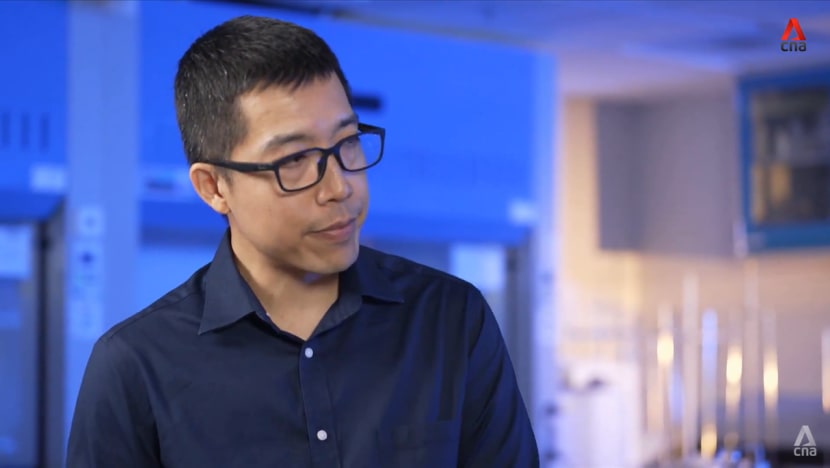Safety measures in place, but expert sees greater risk of sinkholes with climate change
With all the construction work underway in Singapore, the programme Talking Point explores the concerns about geological safety when it comes to sinkholes and finds out what you can do if the earth swallows you.

The sinkhole in Jalan Masjid India, Kuala Lumpur, that swallowed up an Indian tourist last month. Another sinkhole appeared in the area within a week.

This audio is generated by an AI tool.
SINGAPORE: It happened in Malaysia, but the question also arose in Singapore: Are we at risk from sinkholes?
And almost three weeks after a tourist in Kuala Lumpur fell eight metres as the earth opened under her, Singapore’s Building and Construction Authority outlined the measures in place to manage this risk during construction work.
These include builders and engineers monitoring the ground for surface subsidence, it said in a letter to The Straits Times, noting that sinkholes may be caused by tunnelling or excavation work.
Additionally, David Ng, chairman of the Institution of Engineers Singapore’s civil and structural engineering technical committee, told CNA’s Talking Point that construction companies must ensure that retaining walls are built deep enough to block groundwater flow, which could wash soil into the excavation and create voids.
“During the tunnelling process, we’ll measure the excavated volume of soil (taken) out … so that there’s no void underground, created due to over-excavation,” he said.
If there are voids, ground-penetrating radar — which sends radio waves into the ground — is one method of detecting them, he added.
While such measures have minimised the risk of sinkholes forming, another expert thinks Singapore and the region are likely to see more sinkholes because of climate change.
Climate projections indicate both a hotter and wetter future, “especially in Singapore”, stated Stephen Chua, a research assistant professor at the Nanyang Technological University’s Earth Observatory of Singapore. “These extremities actually put a greater strain on the sediments underneath.”

For example, when rainfall saturates the soil, it can undermine the integrity of the ground beneath Singapore’s concrete jungle. And with structural weakening, there is the potential for more holes in the ground, “leading to greater risks of sinkholes”.
Conversely, droughts can lower the water table — the boundary between water-saturated and unsaturated ground — and weaken the soil.
A 2018 study in the United States showed that for every 0.1 degrees Celsius increase in global temperature, sinkhole occurrences increased by 1 to 3 per cent, Chua cited.
While construction practices in Singapore have been “well-managed”, hence the low occurrence of sinkholes, climate change means the protocols must become increasingly stringent, he urged.
HOW TO PROTECT YOURSELF
Low occurrence does not mean no occurrence either. In 2013, sinkholes appeared on Clementi Road, Commonwealth Avenue West and Keppel Road. Excavation for Downtown Line Stage 2 also ruptured an underground water pipe, causing a sinkhole on Woodlands Road.
WATCH: Sinkholes in Singapore — Can we really avoid them? (22:27)
A year later, part of Upper Changi Road East collapsed, sending a tipper truck into the ground near a Downtown Line 3 construction site. In 2022, a sinkhole emerged on a slip road along Farrer Road.
It is unlikely that these were natural sinkholes — which form when acidic water from the atmosphere seeps into the soil, dissolves soluble rocks like limestone and creates underground voids — said National University of Singapore senior lecturer in geography Muhammad Nawaz.
In Singapore, even areas with limestone are not susceptible to naturally occurring sinkholes, he said, as the soil is richer in hard sediments including granite and norite.
There are limestone-rich regions, however, in countries like the Philippines, Thailand and Malaysia, including the cities of Ipoh and KL, where another sinkhole opened just yesterday in front of the KL International Airport’s VIP complex.

Singaporeans who travel should be wary in such places, “especially if there are periods of high rainfall or drought”, Chua cautioned.
It is good practice to be alert to tensile cracks, tilted pillars — which might indicate that the ground has moved — and uneven ground or other deformations, advised Universiti Kebangsaan Malaysia geologist and geohazard expert Goh Thian Lai.
He also advised against the use of mobile phones while walking. The phone will come in useful, however, for making an emergency call if one does fall through a sinkhole, noted wilderness medic Zhang Tingjun from consultancy ZeroRisk International.
Security apps can also be used to share one’s location. “But don’t stay on your phone. If (you do), … you’re draining your battery. And this is your lifeline,” she said.
How to spot signs of a sinkhole forming and ensure pedestrian safety
In the first instance, you should grab hold of “anything you can on the sides, to try and break your fall or give you a chance of staying out of the hole”.
If that fails, it is crucial to assume the brace position that air passengers are shown for emergency landings. “You’d want to protect your head … as you’re falling,” Zhang advised.
If there are … debris or rocks that come down after you, you’re as protected as you can be.”
Then take a deep breath and stay calm. “After you’ve made that emergency call, you’d want to stay in this foetal position,” she continued. “The nature of a sinkhole is that there are loose rocks on the side.”
Try to focus on a light source, the likely direction from which help will come, she added. “That’s going to be … your North Star.”
Watch this episode of Talking Point here. The programme airs on Channel 5 every Thursday at 9:30 p.m.

















